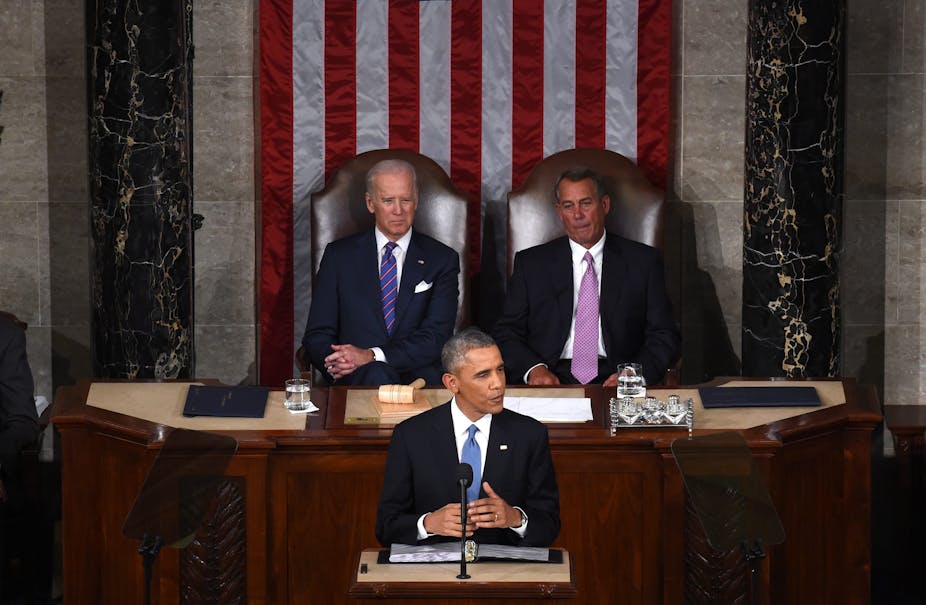On Tuesday night (US time), President Barack Obama gave his second-last State of the Union address – and the last one that has the potential to shape his legacy. Next year the country will be caught up in the primaries for the 2016 election. The president’s agenda will play second fiddle to the proposals of a bevy of aspiring presidential candidates.
But with two years left in his presidency, Obama had the nation’s attention on Tuesday. He used it to outline a vision of post-recession liberalism that was at once hopeful and limited.
Though upbeat and spirited, Obama’s speech served as a studied contrast to the boldness of his recent executive actions. Hemmed in by obstruction in Congress, Obama has, in the last several months, used his authority as president to enact his agenda. Opening relations with Cuba, easing immigration restrictions, ratcheting up carbon regulations – with the clock ticking down on his presidency, Obama has seemed energised and emboldened.
Obama had fun delivering tonight’s speech. He was loose, confident and playful – a welcome change from his previous State of the Union addresses. But his proposals seemed tame in comparison to recent executive actions: lowering mortgage premiums, expanding childcare tax credits, a few years’ of free community college.
These are important policies, to be sure, but nothing particularly daring or innovative.
Obama also outlined a vision he has no chance of delivering. He laid out legislative proposals, but with Republicans controlling both houses of Congress, his odds of getting liberal legislation passed are vanishingly small. In the last two years when Republicans controlled only the House, Obama saw only 5% (2013) and 14% (2014) of his State of the Union proposals enacted into law.
All that Obama might get through Congress – trade agreements and corporate tax reform – are fairly conservative proposals, which will draw more opposition from Democrats than Republicans.
This is why it was so important for Obama to outline a broader, more genuinely liberal plan in this State of the Union. Judged only on what he signs into law in the next few years, Obama will likely appear far more conservative than he would prefer. This speech offered a roadmap for incremental legislative liberalism in the years that follow his presidency, which, if enacted, can be considered part of Obama’s legacy.
From the very start of the speech Obama embraced this long view, saying:
It’s now up to us to choose who we want to be over the next 15 years, and for decades to come.
But more importantly, Obama’s speech was a necessary counterpart to his executive action. His executive actions have been clear and immediate – a welcome relief from an intractable, immobilised Congress.
But the very ease with which executive actions are put in place makes them simple to undo when the next administration comes in. A Republican presidential victory in 2016 could mean all Obama’s executive audacity was for nought. Though it would be difficult to undo the Cuba thaw, carbon caps and deferred deportations would disappear overnight, and with them an important chunk of Obama’s legacy.
Lasting change comes, as it should, through legislation. While Obama knows few of his proposals will become law in the next two years, he has presented a blueprint that can guide Democratic legislators even after he leaves office.
Though not sweeping in scope – Obama did not propose major programs like universal health care or student loan forgiveness or an expansion of programs for the poor – the speech offered instead a liberalism grounded in opportunity and security, an incremental way to reshape the recovery, thus far limited to the wealthiest Americans, along the lines of what Obama called “middle-class economics”.
The 2015 State of the Union, then, was not only about the future but about the past. It showed that the past six years have tempered Obama. He talked about vetoing bills as much as he urged Congress to pass them.
In the best passage of his address, Obama recalled his famous 2004 speech to the Democratic National Convention in which he asserted that:
… there’s not a liberal America and a conservative America; there’s the United States of America.
Obama then noted that, given the polarisation of the past six years, many people had questioned that vision of the United States. “I know how tempting such cynicism may be,” he said. “But I still think the cynics are wrong.”
And they are, in the long view. Hope and change still exist for Obama, but the hopes are more distant, and the changes will have to be made permanent on someone else’s watch.

